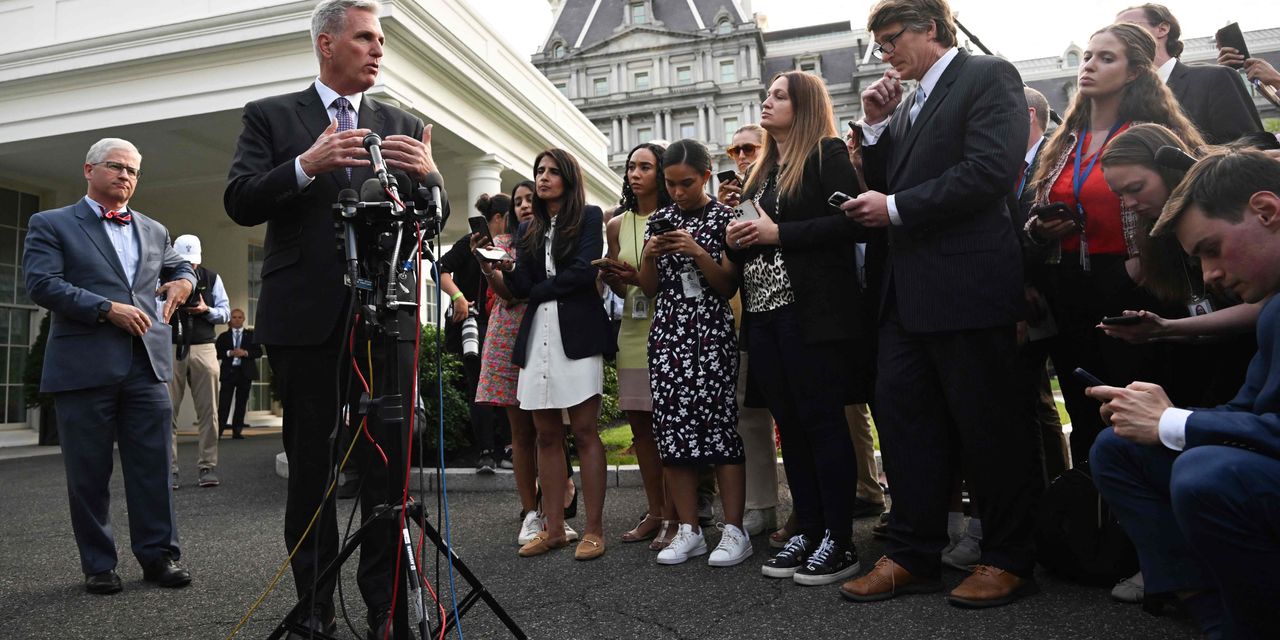Continued uncertainty about whether a debt-ceiling resolution can come together fast enough to avoid a government default pushed yields on Treasury bills maturing between early and mid-June toward 6% on Tuesday.
The yield on Treasury bills maturing on June 6 touched that level before slipping slightly to 5.997% Tuesday afternoon, according to Bloomberg data. Meanwhile, the rate on T-bills maturing on June 8 was at 5.905%.
In addition, the one-year T-bill issued in June 2022 and which matures on June 15 was yielding 6.141%, though analysts said that was likely being impacted by a government auction on Tuesday. That 6.141% yield was the highest of any government obligation maturing within two weeks after the so-called X-date of June 1 — when Treasury Secretary Janet Yellen said the government might be unable to pay all its bills if no action is taken on the debt ceiling.
The Treasury bill market is where debt-ceiling angst has played out the most and Tuesday brought wild trading as investors questioned whether the government will be forced to miss payments after June 1. At the moment, the T-bill market is in a state of dislocation — one in which yields ranged from as little as 2.924% on the government obligation maturing on May 30 to as high as 6.141% on the 1-year bill maturing in three weeks.
The higher the yield on a Treasury obligation, the more investors are demanding to be compensated for the risk of holding that bill. Yields also rise when investors are selling off or staying away from the underlying maturity. Tuesday’s moves suggest that investors and traders are factoring in at least some risk that the government could cross the X-date without a debt-ceiling resolution.
Right now, the market regards bills maturing between June 6 and June 15 as “the most at risk for a delayed payment and no one wants to own” them, said Lawrence Gillum, the Charlotte, N.C.-based chief fixed income strategist at LPL Financial.
“Ultimately, markets expect something to get done, but money managers who have to own those T-bills are not taking any chances,” he said via phone.
For much of Tuesday, the broader financial market appeared to be relatively confident that a debt-ceiling agreement could be reached by June 1, a day after President Joe Biden and House Speaker Kevin McCarthy each described talks as “productive” on Monday. Then came word of McCarthy telling House Republicans on Tuesday that negotiators were nowhere near a deal yet, with Bloomberg citing Republican Representative Ralph Norman and another unidentified person in the room.
All three major U.S. stock indexes
DJIA,
SPX,
COMP,
finished lower, while Treasury yields beyond the 2-year rate slipped toward the end of Tuesday’s New York trading session — a sign of fading optimism in the outlook for the U.S. economy.
Read: ‘Survival of the strongest’: How pandemic-era shifts may upend market’s recession narrative
One of the financial market’s favorite indicators of impending U.S. recessions — the difference between the 2- and 10-year Treasury yields — has been persistently inverted since July 5, 2022. That’s the longest such streak since May 1980, and yet no recession has been declared so far by the only arbiters who matter, those at the National Bureau of Economic Research.
On Tuesday, fed funds futures traders priced in a 28.1% chance of another quarter-point rate hike by the central bank in June, which would take the main policy rate target to between 5.25%-5.5%. They also factored in a slight 5.6% likelihood of another similar-size rate hike in July.
Gillum and Greg Faranello, head of U.S. rates at AmeriVet Securities in New York, said they see a small chance of no debt-ceiling agreement by June 1. Under such a scenario, the Treasury market would fall into “disarray,” with T-bill yields spiking in a manner reminiscent of last year’s crisis of confidence in the U.K. bond market, they said. It would also make it harder for the Fed to hike rates on June 14, and likely lead to a flight-to-quality trade in longer-term Treasurys as equities sell off.
See: ‘Doomsday machine’: Here’s what could happen if the debt ceiling is breached
As of Tuesday, the T-bill market was “definitely showing some signs of stress, there’s no question about it,” Faranello said via phone. Meanwhile, “the economy is doing better than the narrative of recession,” even after the recent turmoil in regional banks, and a move toward 4% in the 10-year rate this year “can’t be ruled out.” However, that could change quickly based on the outcome of the debt-ceiling debate.
Getting something done on the debt ceiling by June 1 “is going to be a challenge,” Faranello said. The risk of default “is small but not a zero-percent probability,” as is the prospect of chaos if negotiators come too close to the wire and create a period of confusion in the Treasury market.
“At a minimum, there would be pretty severe economic damage” from a default or any confusion, it “could be chaotic,” and “you would see that impact on risk assets,” he said.
Read the full article here




